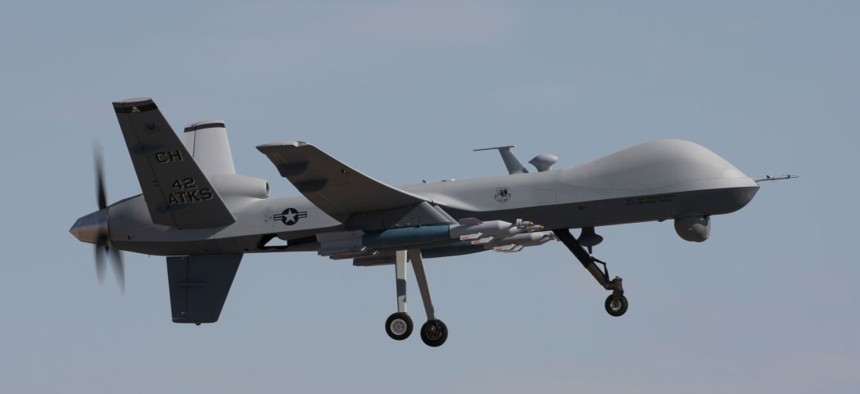As threat landscape changes, Air Force mulls the next unmanned platform
The Air Force is currently looking for drones, large and small, that can operate in contested environments for future conflicts.
Unmanned aerial systems have been an effective tool against terrorist entities, but they have generally operated in what are deemed permissive environments where host countries are on board in fighting non-state groups.
As the U.S. gears up for what the Defense Secretary Ashton Carter calls full-spectrum operations against high-end enemies – countries such as Russia and China that are much more technologically advanced than non-state groups – slow-moving drones will be easy targets for capable nation-state anti-aircraft and radar capabilities.
One of the problems for the military currently is that the demand for intelligence, surveillance and reconnaissance – a primary mission for unmanned systems – is so high that training operators and updating infrastructure is nearly impossible. “Essentially, right now we don’t have the opportunity to train because we are pretty much all in on the current engagement level,” Air Force Lt. Gen. Robert Otto, deputy chief of staff for Intelligence, Surveillance and Reconnaissance, said at a Feb. 16 breakfast hosted by AFCEA’s Washington, D.C., chapter.
Otto's comments were echoed by Brig. Gen. John Rauch, director of Intelligence, Surveillance and Reconnaissance Capabilities. “One of the challenges we face right now is they’re so employed that when we go out and do something like Red Flag [a training exercise] they’re not there all the time,” he told Defense Systems following the event.
Rauch said that the Air Force is trying to figure out how to continue current operations while conducting training and updating the current infrastructure to operate in a contested environment. Another challenge is envisioning what a new platform will look like, which entails several aspects, including whether, on certain missions, they need an unmanned capability at all.
“But what we’re trying to do now is really get around and figure out what do we really need, what sort of sensors, what type of things need to be sensed, what capability do we need and figure out how do you deliver that,” he said. “Does it need to be manned or unmanned…is it a high altitude, is it medium, is it both, is [full motion video] we’re looking for, hyperspectral [imaging], what’s that next thing that we’re going to need, and that’s one of the reasons why we really want open mission systems because whatever we decide today if that platform is going to be around for the next 25 years, we know between now and the time it retires things are going to change in the environment.” He added retrofitting sensors to platforms is another important consideration.
Breaking up the problem by airspace operation, Rauch said operators that fly medium altitude unmanned platforms such as the MQ-1 Predator or MQ-9 Reaper are thinking in terms of what the MQ-X of the future is. The Air Force in its most recent budget proposal requested 24 additional Reapers. But in terms of newer procurements for next-generation medium altitude platforms, the Air Force reportedly was unimpressed with the Avenger drone made by General Atomics, also the manufacturer of both the Reaper and Predator. According to documents obtained by War is Boring, the Air Force found that the Avenger only “offered only minor improvements over the MQ-9,” and passed on procurement of the platform, which its contractor says is faster and stealthier.
In the high altitude realm, the manned U-2 is being phased out, so the Global Hawk will begin to take on a much larger role, with updates and retrofits to its sensor suites to make up for the capabilities that will be lost when the U-2 is retired.
Another aspect of next-gen drones is autonomy and their ability to work together. Swarming techniques have been one described method for contested environment operation, but this generally relates to an attack operation and not necessarily ISR, which typically involves hours of loitering over a particular target. Small, and in some cases expendable, drones that can be launched from larger platforms mid-air can overwhelm adversaries’ radar and anti-aircraft systems, enabling manned or more sensitive assets to penetrate enemy defenses. Rauch said expendable platforms are something the Air Force is looking at.
The Air Force is readying a small-UAS flight plan, Otto said, which should be ready in about four months. The plan will address topics concerning swarming as well as others such as manned-unmanned teaming. “If you needed coverage—say, radar target over a certain area—there are a couple ways to accomplish that, and one can be smaller assets that could all fill in a piece of the pie,” Otto said. There is not much additional information available on the plan at the moment, though an Air Force spokesperson said that it will be released as a strategy document and not a request for information.
The document will represent “the first vision statement dedicated to integrating Small UAS (SUAS) into the larger Air Force strategy,” Capt Trisha Guillebeau, an Air Force spokesperson told Defense Systems via email. “The SUAS Flight Plan will guide Air Force leaders toward investments that reverse the cost curve through development of innovative, integrated SUAS capabilities to resolve operational needs historically addressed with large platforms at significant cost.”
The document will address UAS from Group 1 to Group 3, which includes everything from micro-drones to ones weighing less than 1,320 pounds, including the RQ-7B Shadow.





